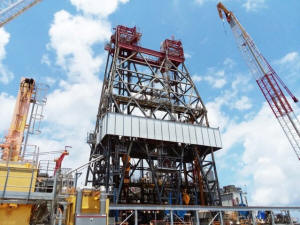|
In disaster's wake, BP doubles down on
deepwater despite surging shale
 Send a link to a friend
Send a link to a friend
 [June 27, 2017]
By Jessica Resnick-Ault [June 27, 2017]
By Jessica Resnick-Ault
THUNDER HORSE OIL PLATFORM, Gulf of Mexico
(Reuters) - About 300 BP workers commute 150 miles here by helicopter,
from the Louisiana coast to a deep-sea drilling platform that can
produce more oil in a day than a West Texas rig can pump in a year.
On the deck of Thunder Horse, they work two-week shifts, drink seawater
from a desalination plant, and eat ribs and chicken ferried in by boat.
On the ocean floor, robots provide remote eyes and arms as drills
extract up to 265,000 barrels per day.
"There's a whole city below us," said Jim Pearl, Marine Team Leader on
the platform.
This is just one of the four Gulf of Mexico platforms on which BP has
staked its future in U.S. oil production.
Seven years after its Deepwater Horizon explosion and oil spill, BP is
betting tens of billions of dollars on the prospect that it can slash
the costs of offshore drilling by half or more - just as shale oil
producers have done onshore.

The firm says it can do that while it continues to pay an estimated $61
billion in total costs and damages from the worst spill in history - and
without compromising safety.
BP's Gulf platforms are key to a global strategy calling for up to $17
billion in annual investments through 2021 to increase production by
about 5 percent each year, Chief Executive Officer Bob Dudley recently
told investors.
"Our strategy is to take this investment that we spent so much money
building, and keep it full" to the platform's capacity, Richard
Morrison, BP's regional president for the Gulf of Mexico, told Reuters
during the first tour of a BP Gulf drilling platform since the disaster.
"We're also exploring for larger pools of oil."
BP's deepwater double-down is all the more striking for the contrast to
its chief competitors, who have cooled on offshore investments in light
of the lower costs and quicker returns of onshore shale plays.
While BP has some onshore U.S. developments, the firm is notably absent
from the industry's rush into shale oil fields of the West Texas Permian
Basin.
Majors including Exxon Mobil Corp <XOM.N>, Chevron Corp <CVX.N> and
Royal Dutch Shell <RDSa.L> have maintained Gulf operations but focused
expansions on U.S. shale. Exxon Mobil doubled its acreage in the Permian
in a deal earlier this year.
Freeport-McMoRan <FCX.N> and Devon Energy Corp <DVN.N> have pulled out
of Gulf drilling entirely in recent years. Anadarko Petroleum Corp
<APC.N> took a $435-million dollar write-down in May on its Shenandoah
project in the Gulf, deciding it could not profit with oil prices
hovering at about $50 a barrel.
"In a $50 to $60 world, we always felt like greenfield development, in
the Gulf in particular, was fairly challenged," Anadarko CEO Al Walker
told investors last month.

Oil prices dropped steeply last week, settling in the low $40s per
barrel.
BP says its next Gulf development - the $9 billion Mad Dog phase two -
would be profitable even at $40 a barrel. As recently as 2013, BP
reported that it could not start new deepwater Gulf projects at prices
lower than $100 a barrel.
A BILLION BARRELS
In time, BP's offshore expansion could produce a huge payoff. The firm
announced last month that it had discovered an additional billion
barrels of oil below its four audaciously named Gulf platforms - Thunder
Horse, Atlantis, Na Kika and Mad Dog.
The find - worth more than $40 billion at today's market prices -
amounts to more than three times the proven reserves at the Na Kika
field, or the equivalent of three new fields in the Gulf.
"It seems like every ten years there's another breakthrough" that
unlocks more Gulf oil, Morrison said on the deck of Thunder Horse.
Over his shoulder, a drillship three miles away tapped a new well that
will feed production into the massive platform.
In the wake of the 2010 BP disaster, deepwater production was curtailed
by a six-month U.S. government moratorium on drilling and a longer
period of uncertainty about regulation. But output has rebounded to new
record highs as projects sanctioned years ago start operations and
existing hubs such as Thunder Horse expand.

BP's big new discovery is key to its slashing of estimated per-barrel
costs, as are a host of drilling innovations and more favorable deals
with service providers.
For eight decades, geologists have used seismic imaging to estimate oil
and gas reserves beneath the rocky undersea terrain.
[to top of second column] |

A massive drilling derrick is pictured on BP's Thunder Horse Oil
Platform in the Gulf of Mexico, 150 miles from the Louisiana coast,
May 11, 2017. Picture taken May 11, 2017. REUTERS/Jessica
Resnick-Ault

BP used its own new technology for the billion-barrel discovery.
Called full waveform inversion, the technique uses massive amounts
of data to create a high-resolution model of reserves that were
previously hidden beneath salt deposits.
The firm also aims to tap those reserves without building new
multi-billion-dollar platforms.
At Thunder Horse and other platforms, BP is installing wellheads on
the seabed and connecting them to pipelines that rise up to existing
platforms, like the legs of a spider.
These "tiebacks" allow producers to feed oil from remote regions of
fields that previously went untapped.
Other design changes helped BP hold down the investment in Mad Dog's
second phase from an initially estimated $20 billion to just $9
billion, the company said. Such savings are part of the equation BP
uses to estimate the platform's profitability at oil prices of $40 a
barrel.
The struggles of deepwater oil service firms - who were forced to
cut prices after per-barrel prices tanked in 2014 - are also keeping
BP's expansion costs low.
"If you're going to be building an offshore Gulf of Mexico platform,
now is the time to be doing it," said Norm MacDonald, portfolio
manager for Invesco's energy fund, which has increased its stake in
BP, its second-largest holding.

Other funds remain leery of offshore investments because of the
longer wait for a return in a volatile industry.
Shale has a "liquidity premium" because producers can make smaller
investments and recoup them sooner, within two or three years, said
Michael Roomberg, a portfolio analyst at Miller-Howard Investments.
Tie-backs and other advances, however, could accelerate deepwater
returns and help narrow the liquidity gap with shale, MacDonald
said.
COST CUTTING, SAFETY CONCERNS
BP's growing deepwater investments irk some environmentalists, who
say the company has fought paying what it owes to restore shorelines
and communities damaged by its massive spill.
They also see the threat of another disaster.
"They never really fulfilled those promises, and people are very
skeptical about them expanding drilling," said Raleigh Hoke,
campaign director at Gulf Restoration Network in New Orleans.
Richard Sears - who served as chief scientist on the National
Commission on the BP Deepwater Horizon Oil Spill and Offshore
Drilling - said such projects can be managed safely at low oil
prices.
The causes of the BP disaster had more to do with poor
decision-making and slipshod safety systems than cost-cutting, said
Sears, who previously managed production projects at Shell.

BP said it has bolstered safety operations globally since the spill,
introducing a safety and operational risk staff with 800 positions
and an internal global wells organization to standardize drilling
practices, among other measures. The company says it cannot
precisely estimate new spending on safety since the spill because
its efforts are integrated into many parts of the company.
In a glassed-in drilling shack on the Thunder Horse platform,
operators stay connected to a new onshore command center in Houston
that BP designed to monitor data from offshore wells.
On the deck below sits a blowout preventer, a room-sized piece of
equipment that would soon be fitted on the wellhead of a drilling
site, two miles under water.
But first it would need a safety inspection - unlike the blowout
preventer that infamously failed to contain the 2010 spill, which
federal regulators have said had not been inspected in years.
(Editing by David Gaffen, Simon Webb and Brian Thevenot)
[© 2017 Thomson Reuters. All rights
reserved.]
Copyright 2017 Reuters. All rights reserved. This material may not be published,
broadcast, rewritten or redistributed.
 |